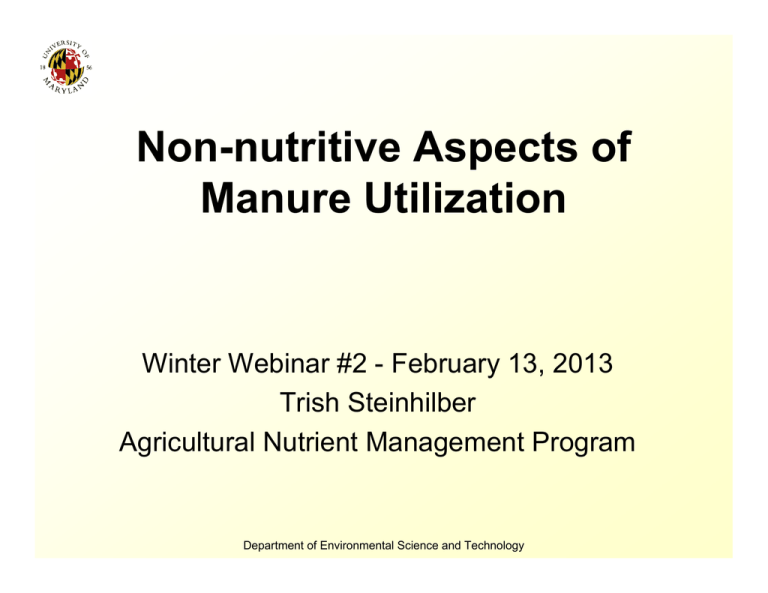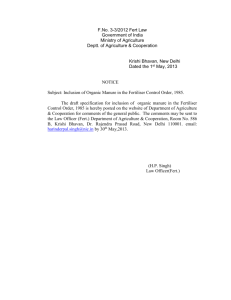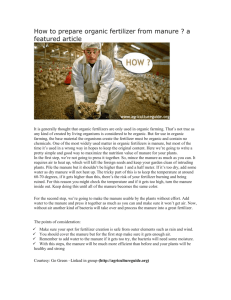Non-nutritive Aspects of Manure Utilization Winter Webinar #2 - February 13, 2013
advertisement

Non-nutritive Aspects of Manure Utilization Winter Webinar #2 - February 13, 2013 Trish Steinhilber Agricultural Nutrient Management Program Department of Environmental Science and Technology Today’s Topics • organic carbon – biological, physical and chemical properties • greenhouse gas production • disease-prevention or treatment compounds • residuals from crop protection chemicals used in production of animal feed Department of Environmental Science and Technology Manure: A Heterogeneous Material • a mixture of metabolic waste & solid waste from the digestive system – metabolic waste is soluble • urea (mammals), uric acid (birds), soluble materials – feces is a mixed bag • undigested feed • microbes, including human pathogens • cell wall debris from animal gut – feces or urine can contain growth promoting substances, hormones, chemicals from feed Department of Environmental Science and Technology Organic Carbon (OC) • organic carbon additions with manure use – 2 tons poultry litter provides 3/4 ton OC – 20 ton dairy manure provides 3.2 tons OC • compared to 1.3 tons of OC for corn stover from a 170 bu/C grain crop Department of Environmental Science and Technology Impacts of Organic Carbon Additions • cascading series of benefits from organic inputs – stimulates biological activity • feeds the semi-starving microbes – crop roots and microbes exude binding agents • plant and microbial mucilages – – – – increase in large aggregates/improve soil structure decrease in bulk density/increase in pore space increase in infiltration rate and hydraulic conductivity improve soil tilth or soil quality Department of Environmental Science and Technology Department of Environmental Science and Technology Microbial Biomass • Alabama, 10 years of poultry litter (PL) • Decatur silt loam • commercial fertilizer and PL at comparable rates of N, phosphate and potash Department of Environmental Science and Technology Microbial Biomass N (Particulate Organic N or PON) commercial fertilizer poultry litter Microbial Biomass N (MBN) (pounds per acre) 176 PON (T/acre) 231 2.8 2.4 PON is a measure of coarse undecomposed organic N and is believed to be a labile pool (0.53mm screen) Department of Environmental Science and Technology Genetic Look at Organisms • Liu at al. NCSU (2007, SBB) – several organic amendments – Orangeburg sandy loam • soils treated with litter and other organic sources had more diversity and richness among microbes • ability to use a wider array of substrates as energy/food source Department of Environmental Science and Technology Soil Respiration (CO2 Evolution) N source CO2 evolved (mg CO2/kg soil) ammonium nitrate 26 poultry litter 36 green manure (V&R) 29 Equivalent amounts of PAN in commercial fertilizer and organic amendment treatments, NC State, Lui et al., SBB, 2007; average of year 5 & 6 of experiment; amendments in mid-May; tomatoes planted in late May; measurements taken in August Department of Environmental Science and Technology Adapted from Haynes & Naidu, 1998, NCA-E Department of Environmental Science and Technology Aggregate Stability • ability of aggregates to withstand disruption – attempt to disrupt aggregates – measure quantity of aggregates that are intact • dairy manure and commercial fertilizer on alfalfa – CMREC Clarksville high manure rate>low manure rate>fertilizer> control Department of Environmental Science and Technology Manure and Greenhouse Gases • CO2, CH4 (methane), N2O (nitrous oxide) – CH4 • 20 times as potent per molecule as CO2 – N2O • is 300 time as potent per molecule as CO2 • “laughing gas” • N2O is a product of denitrification – occurs under anaerobic conditions – heterotrophic organisms convert NO3- to and to N2O and/or N Department of Environmental Science and Technology Nitrogen Sources and N2O • field experiment in Kentucky • Crider silt loam • all N sources applied at 150 pound per acre rate – urea, ammonium nitrate – EEFs & additives – poultry litter • static chambers • 2-3 times a week extracted gas from chambers Department of Environmental Science and Technology Department of Environmental Science and Technology N2O per unit Grain Yield g N2O-N per bu N Source Super U UAN UAN Agrotain Plus ESN urea NH4NO3 poultry litter poultry litter Agrotain Plus control Department of Environmental Science and Technology 7.0 6.0 6.9 12.6 6.2 8.0 41.1* 37.4* 5.1 No surprises here! • litter supplied labile C, not just N • soils went anaerobic during the season • heterotrophs used the larger labile C supply to denitrify more nitrate • replicated in many locations over last 15 years • CH4 was not impacted by N sources Department of Environmental Science and Technology Veterinary Pharmaceuticals • antibiotics and ionophores – antibiotics – usually anti-bacterials • some used for both human and veterinary populations – ionophores – used only for animals • pass through the animal unmetabolized • impact soil organisms • uptake by plants Department of Environmental Science and Technology Veterinary Pharmaceuticals in Animal and Plant Products • Average Daily Intake (ADI) • Maximum residue levels – established for animal products by JECFA • less than the amount that would trigger allergic reaction in sensitive folks • amount that could be ingested daily with no lifetime health risks Department of Environmental Science and Technology MN, Kumar and Dolliver, greenhouse, swine manure, sulfamethazine Department of Environmental Science and Technology Sulfamethazine Uptake by Vegetables • maximum residue level in animal products of 0.1 mg/kg fresh weight • average of 3 vegetables was 0.05 mg/kg • ADIsulfamethazine = 5mg/kg of body weight per day • even with a vegetable-based diet, daily intake would not exceed ADI Department of Environmental Science and Technology Herbicide Carryover • manure may contain active ingredients from herbicides used for weed control in crops subsequently fed to animals – pyridine carboxylic acid family – clopyalid, picloram, fluoroxypyr, triclopyr • Stinger, Reclaim, Forefront, Milestone – broadleaf weed control in pastures, hay fields and golf courses – not metabolized by herbivores – excreted in manure – not readily altered by composting Department of Environmental Science and Technology Pyridine Carboxylic Acid Family • clippings from treated urban lawn caused severe plant damage to users of yard waste compost in several major cities • manure from animals fed hay or grazing pastures • auxin-like chemicals • severe deformation, stunting or death of plants Department of Environmental Science and Technology Ohio State Extension Department of Environmental Science and Technology Questions or Comments? Department of Environmental Science and Technology




